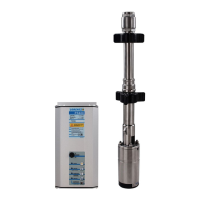63
13.9 Glossary of Solar Electricity and Water Pumping
Courtesy of
Dankoff Solar
Products, Inc.
2810 Industrial Rd.
Santa Fe, NM USA 87505
(505) 473-3800
www.dankoffsolar.com
Basic Electricity
AC - Alternating Current, the standard form
of electrical current supplied by the utility grid
and by most fuel-powered generators. The
polarity (and therefore the direction of current)
alternates. In U.S.A., standard voltages for
small water pumps are 115V and 230V.
Standards vary in different countries. See
inverter.
DC - Direct Current, the type of power
produced by photovoltaic panels and by
storage batteries. The current flows in one
direction and polarity is fixed, defined as
positive (+) and negative (-). Nominal system
voltage may be anywhere from 12 to 180V.
See voltage, nominal.
Current - The rate at which electricity flows
through a circuit, to transfer energy. Meas-
ured in Amperes, commonly called Amps.
Analogy: flow rate in a water pipe.
Efficiency - The percentage of power that
gets converted to useful work. Example: An
electric pump that is 60% efficient converts
60% of the input energy into work - pumping
water. The remaining 40% becomes waste
heat.
Energy - The product of power and time,
measured in Watt-Hours. 1000 Watt-Hours =
1 Kilowatt-Hour (abbreviation: KWH). Varia-
tion: the product of current and time is
Ampere-Hours, also called Amp-Hours
(abbreviation: AH). 1000 watt consumed for 1
hour = 1 KWH. See power.
Converter - An electronic device for DC
power that steps up voltage and steps down
current proportionally (or vice-versa). Electri-
cal analogy applied to AC: See transformer.
Mechanical analogy: gears or belt drive.
Inverter - An electronic device that converts
low voltage DC to high voltage AC power. In
solar-electric systems, an inverter may take
the 12, 24, or 48 volts DC and convert it to
115 or 230 volts AC, conventional household
power.
Power - The rate at which work is done. It is
the product of Voltage times Current, meas-
ured in Watts. 1000 Watts = 1 Kilowatt. An
electric motor requires approximately 1
Kilowatt per Horsepower (after typical effi-
ciency losses). 1 Kilowatt for 1 Hour = 1
Kilowatt-Hour (KWH).
Three-Phase AC - Three phase power is AC
that is carried by three wires. Power waves
are applied in a sequence. Three-phase is
used for large industrial motors, variable-
speed motors, and brushless solar water
pump motors. Analogy: 3-cylinder engine.
Transformer - An electrical device that steps
up voltage and steps down current proportion-
ally (or vice-versa). Transformers work with
AC only. For DC, see converter. Mechanical
analogy: gears or belt drive.
Utility Grid - Commercial electric power
distribution system. Synonym: mains.
Voltage - The measurement of electrical
potential. Analogy: Pressure in a water pipe.
Voltage Drop - Loss of voltage (electrical
pressure) caused by the resistance in wire
and electrical devices. Proper wire sizing will
minimize voltage drop, particularly over long
distances. Voltage drop is determined by 4
factors: wire size, current (amps), voltage,
and length of wire. It is determined by
consulting a wire sizing chart or formula
available in various reference tests. It is
expressed as a percentage. Water analogy:
Friction Loss in pipe.
Voltage, Nominal - A way of naming a range
of voltage to a standard. Example: A “12 Volt
Nominal” system may operate in the range of
11 to 15 Volts. We call it “12 Volts” for
simplicity.
Solar Electricity
Charge Controller - A device that regulates
the charge current to a battery in order to
prevent overcharge. It prevents excessive
voltage and maximizes the longevity of a
battery. It may also contain other control
functions (see Low Voltage Disconnect).
Deep Cycle Battery - Batteries that are
designed to discharge as much as 80% of
their capacity, hundreds of times. They differ
from engine-starting batteries by having
thicker plates and different metal alloys.
Low Voltage Disconnect - A control function
in a battery-based power system in which the
load or loads are disconnected before the
battery gets over-discharged. Over-discharge
will damage a lead-acid battery. Typical
settings for a 12V system are 10.5 or 11V
disconnect and 12.5 or 13V reconnect.
Photovoltaic - The phenomenon of convert-
ing light to electric power. Photo = light, Volt
= electricity. Abbreviation: PV.
PV - The common abbreviation for photo-
voltaic.

